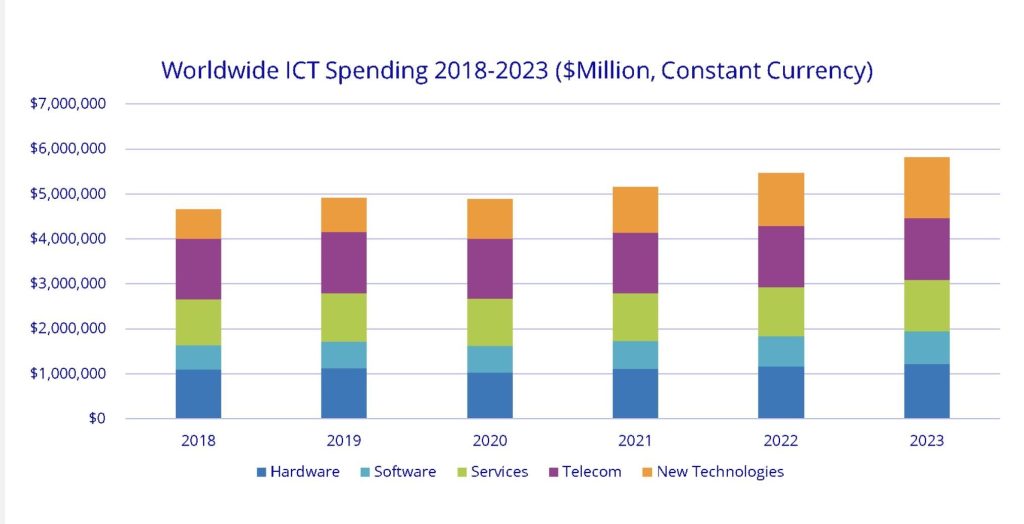The Covid-19 pandemic disruption has reset organizations globally. If we think about the lockdown and restrictions as a ‘metamorphosis process’, we could say that businesses will emerge from the cocoon with extra wings powered by an accelerated digital transformation. As enterprises rebuild and replan, the digital CEO agenda shifts to a digital-first world that may require new investments.
Spending on Digital Transformation will continue to grow as we move forward. According to market research firm International Data Corporation (IDC), the global investment in Digital Transformation technology is set to grow at an annual compound rate of 17.1 percent, reaching a staggering $2.3 trillion, or 53 percent of all ICT (Information Communication Technology) spending by 2023.

Source: IDC
Before the Covid-19 pandemic, ICT spending was showing healthy, consistent growth. This remained relatively flat during 2020. Since 2021, the overall industry has reflourished with over 2x GDP.
According to IDC research, IoT (Internet of Things) is contributing to significant market growth. Within 5 to 10 years, new and emerging technologies such as robotics, Artificial Intelligence, and VR/AR will also continue to expand to represent over 25 percent of the total ICT spending.

Over the next five years, all growth in traditional technology spending will focus on four platforms: Cloud, mobile, social, and big data/analytics. Cost savings generated by cloud and automation will translate into spending diverted toward new technologies such as Artificial Intelligence, robotics, VR/AR, and blockchain. Next-generation security will also continue to drive significant growth.
Digital Transformation calls for a Digital CEO (DCEO)
If not already part of the organization, the future enterprise in a digital-first world requires the creation of a digital-first CEO. Leaders not only have to manage current/post-pandemic challenges but also the possibility of future unexpected challenges as well. Increased scope, an emphasis on results, and widespread use of metrics to define success are some of the outcomes that IDC reported as findings through their research.
Philip Carter, GVP of IDC’s C-Suite Tech Research, says that as we move from a period of extreme volatility to a slightly steadier but still uncertain business environment, the decisions that CEOs are making now will set the stage for the organizations to potentially thrive over the next few years.
“As part of this,” he says, “our CEO Research reflects the acceleration to a digital-first approach for business leaders to solve the increasingly complex challenges facing society globally. According to Carter, the top 10 CEO priorities that IDC has identified reflect the key areas that CEOs need to address in order to prepare for 2022 and beyond.
Digital Transformation into the future: What’s next for global leaders?
- Accelerated DX Investments Create Economic Gravity
The economy remains on course to its digital destiny with 65 percent of global GDP digitalized by 2022, and will drive over $6.8 trillion of direct DX investments from 2020 to 2023. - Digital Organization Structures and Roadmaps Mature
By 2023, 75 percent of organizations will have comprehensive digital transformation (DX) implementation roadmaps, up from 27 percent today, resulting in true transformation across all facets of business and society. - Digital Management Systems Mature
By 2023, 60 percent of leaders in G2000 organizations will have shifted their management orientation from processes to outcomes, establishing more agile, innovative, and empathetic operating models. - The Rise of the Digital Platform and Extended Ecosystems
By 2025, driven by volatile global conditions, 75 percent of business leaders will leverage digital platforms and ecosystem capabilities to adapt their value chains to new markets, industries, and ecosystems. - A Digital First Approach
While ‘digital first’ prevails in every experience, 60 percent of enterprises will invest heavily in digitalizing employee experience in 2021, transforming the relationship between employers and employees. - Business Model Reinvention
By 2021, at least 30 percent of organizations will accelerate innovation to support business and operating model reinvention, fast-tracking transformation programs to future-proof their businesses. - Sustainability and DX
By 2022, the majority of companies will realize greater value by combining digital and sustainability, giving rise to digitally-driven and sustainably-enabled projects as the de-facto standard. - Digitally Native Cultures
To thrive in the digital supremacy economy, 50 percent of enterprises will implement an organizational culture optimized for DX in 2025, based on customer-centric and data-driven approaches. - Accelerating Digital Experiences
By 2022, 70 percent of all organizations will have accelerated use of digital technologies, transforming existing business processes to drive customer engagement, employee productivity, and business resiliency. - Business Innovation Platforms
By 2023, 60 percent of G2000 companies will build their own business innovation platform to support innovation and growth in the new normal.
Digital Transformation is a transformative journey. The eBook, Speeding Your Digital Transformation Journey, can help you discover how your digital transformation journey compares in a world where staying relevant and ahead of change is paramount for achieving future success.